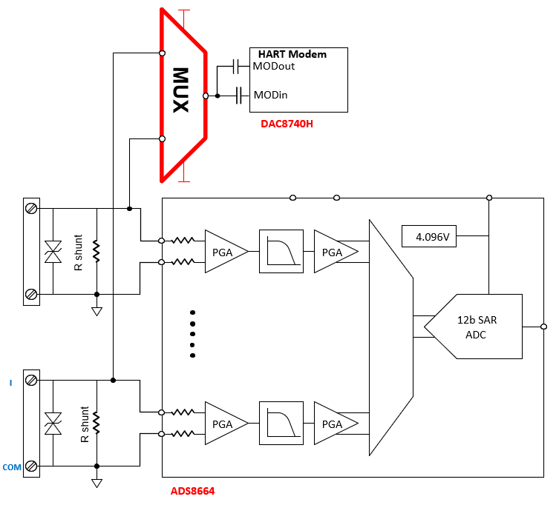SCDT003 March 2024 DAC8740H , TMUX6219
What is Hart Protocol?
HART (Highway Addressable Remote Transducer Protocol) is a bidirectional protocol that is used to facilitate communication between smart transmitters and a host control system. The information that is transmitted between devices during HART contains diagnostic, calibration, troubleshooting, and transmitter readings. For example, a temperature sensor can send a 7mA signal to an ADC which can represent an 80° Fahrenheit reading.
HART protocol helps system operators monitor multiple pieces of equipment in a factory automation environment without physically having to locate and test equipment. The increased communication that is enabled by HART can expand productivity and help anticipate potential failures which in turn saves designers time and money.
How does HART Work?
- A HART transmission is a frequency shift keyed (FSK) signal superimposed on a 4-20mA signal (Figure 1).
- HART is also half-duplex which means the host can communicate with a field transmitter and the field transmitter can communicate back to the host.
- Field devices send a 4-20ma analog signal called a primary variable (PV) to the data converter in the analog input module which represents what the field devices are measuring (examples being temperature, flow, or pressure).
- A HART modem like the DAC8740H modulates/demodulates either a 1.2kHZ or 2.2kHZ signal using Frequency-Shift Keying (FSK) to represent 1 and 0 respectively. The digital signal contains information from both the host and field transmitter that includes device status, diagnostics, and additional measured or calculated values.
 Figure 1 HART Communication-Frequency
Shift Keying (FSK) on 4-20 ma Signal
Figure 1 HART Communication-Frequency
Shift Keying (FSK) on 4-20 ma SignalWhy use a MUX in your HART Application?
One problem that occurs in system design is how to increase the number of field devices in the Hart network without using more than 1 Hart Modem. Traditional Hart modems have one input channel to allow them to connect to only one field device. If a system designer wanted to communicate with multiple field devices, the designer needs to use more Hart modems which can be expensive and difficult to implement in a design.
Multiplexers solve this problem by allowing designers to connect multiple field devices to communicate to 1 Hart Modem. This increases the functionality of the system and reduces the cost incurred if multiple Hart modems were used in a design. Figure 2 below is the point-to-point implementation of HART communication which is popular in industrial communication system designs. In the below picture, the ADC digitizes the voltage across the R shunt and calculates the current produced from the smart transmitter which gives the primary variable value. Next, the DAC8740H’s input (MOD_IN) demodulates the received FSK signal and the output (MOD_OUT) modulates an FSK signal to communicate with the field transmitters. Finally, because HART is half-duplex, both the input and output can couple to the same node. HART provides a complete industrial communication design that is simple to use, low-cost, and extremely reliable.
 Figure 2 Multiplexing HART Signals for
Current AIN (Point to Point)
Figure 2 Multiplexing HART Signals for
Current AIN (Point to Point)Design Considerations
- Select multiplexers with Low Ron and Low Ron Flatness. This helps HART communication be as accurate as possible by minimizing signal distortion.
- Since HART is half-duplex, both the Modem's input and output can couple to the same node meaning a 1-channel mux needs to be used. Next, designers must select the number of mux inputs depending on the desired number of field devices that are to be connected to the Hart Modem. For example, if 16 devices are intended to be connected to the Hart modem then a 16:1 1 channel multiplexer like the CD74HC4067 needs to be used.
- Many TI analog switches can support HART because of their bandwidth which is usually in the MHz range and the analog switches can support any current between 4-20ma through the io pins.
- HART Modems like the DAC8740H can operate on power supplies ranging from 2.7 to 5.5V. Designers need to select multiplexers that can operate at a similar power supply as the HART modem.
- Learn about multiplexer parameters with TI Precision Labs Videos.
- Ask a question on our TI E2E™ Design Support Forum.
| Part Number | VCC Range (V) | Configuration | RON (Ω) | RON FLAT(Ω) |
|---|---|---|---|---|
TS5A3159 | 1.65 to 5.5 | 2:1 1-channel | 1 | 0.223 |
TMUX6219 | 4.5 to 36 | 2:1 1-channel | 2.1 | 0.5 |
| TMUX1204 | 1.08 to 5.5 | 4:1 1-channel | 5 | 1.5 |
| TMUX1208 | 1.08 to 5.5 | 8:1 1-channel | 5 | 1.5 |
CD74HC4067 | 2 to 6 | 16:1 1-channel | 70 | 5 |
References
- Texas Instrument, Implementing HART in PLC Analog Input Modules for Real-Time Communication in 4-20mA Systems application brief.
- Texas Instrument, Back to the Basics: What Is HART Protocol and How Does It Work? technical article.
- Texas Instrument, A Basic Guide to the HART Protocol application note.